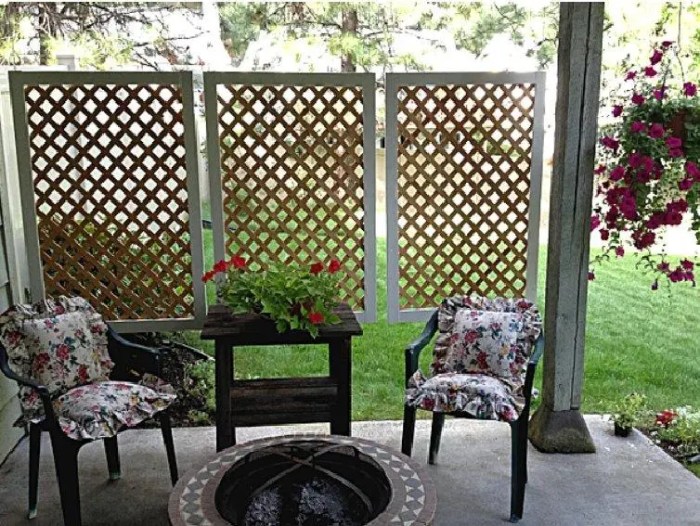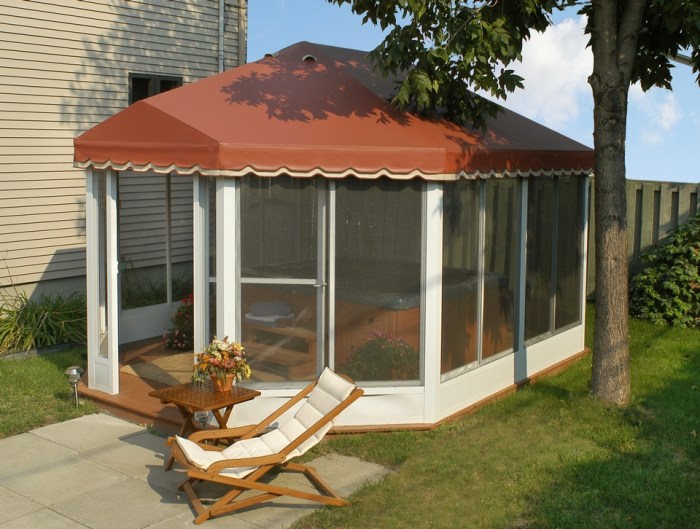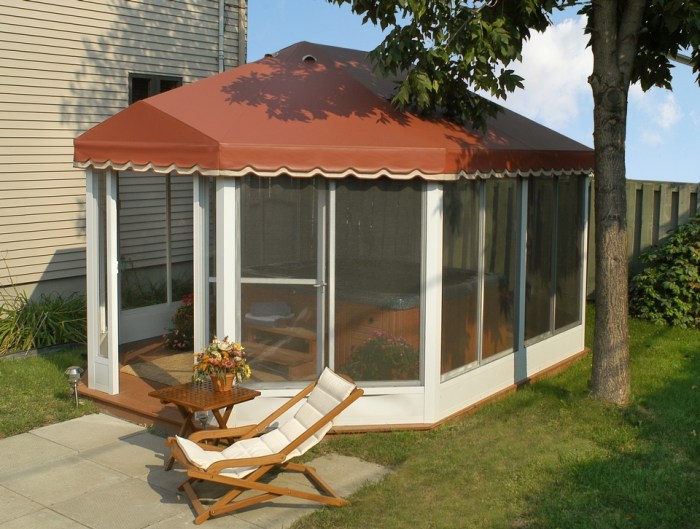DIY patio screen sets the stage for creating a personalized outdoor haven, offering a blend of functionality and aesthetic appeal. From choosing the right screen type to incorporating custom features, this comprehensive guide empowers you to transform your patio into a comfortable and inviting space.
Transform your patio into a haven of relaxation and enjoyment with a DIY patio screen. This project allows you to personalize your outdoor space, creating a barrier against pesky insects, unwanted glances, and harsh weather conditions. Whether you’re seeking a cozy retreat for evening gatherings or a sun-drenched sanctuary for afternoon reading, a DIY patio screen provides the perfect solution.
Planning and Preparation

Before diving into the construction of your DIY patio screen, it’s crucial to have a solid plan in place. This includes everything from determining the screen’s size and style to sourcing materials and securing any necessary permits.
Design and Dimensions
A well-defined design is essential for a successful patio screen project. Consider the following factors when planning:
- Screen Size: Measure the area you want to enclose. Factor in the width and height of the screen panels and any desired overhang.
- Screen Style: Choose a design that complements your patio’s aesthetic. Options include traditional lattice, modern metal panels, or even a combination of materials.
- Functionality: Think about the screen’s purpose. Do you want privacy, shade, or both? Will you need a gate or access point for entry and exit?
Material Selection
The materials you choose will impact the screen’s durability, aesthetics, and cost. Consider these options:
- Framing: Common choices include pressure-treated lumber, aluminum, or vinyl. Pressure-treated lumber is durable and resistant to rot, while aluminum and vinyl are low-maintenance and weather-resistant.
- Screen Panels: Options range from traditional lattice to metal mesh, vinyl panels, and even fabric. Lattice provides a classic look, while metal mesh is durable and offers good ventilation.
- Hardware: Choose high-quality fasteners, hinges, and latches for a secure and long-lasting screen.
Location and Installation
The location and installation method will influence the screen’s stability and effectiveness.
- Site Preparation: Clear any obstacles from the installation area, level the ground, and ensure adequate support for the screen’s posts. Consider using concrete footings for added stability, especially in areas with high winds.
- Post Placement: Determine the location of the screen’s posts, ensuring they are spaced evenly and provide adequate support. Use a level to ensure the posts are plumb.
- Installation Method: Decide whether to attach the screen to existing structures, such as a fence or wall, or build a freestanding structure. For freestanding screens, consider using pre-made posts or building your own.
Budgeting and Sourcing
It’s essential to have a realistic budget in mind before starting your project.
- Material Costs: Research prices for various materials and compare options to find the best value. Consider shopping at multiple retailers or using online resources for price comparisons.
- Labor Costs: If you’re not comfortable with DIY, factor in the cost of hiring a contractor. Be sure to get multiple quotes and compare rates.
- Permits and Approvals: Check with your local building department for any required permits or approvals. These may vary depending on the size and complexity of your screen project.
Framing and Installation: Diy Patio Screen

Now that you have your materials and a clear plan, it’s time to get your hands dirty and build the frame for your patio screen. The frame provides the structure for the screen material, ensuring it stays taut and provides the desired level of privacy and protection.
Building a Sturdy Frame
The frame is the backbone of your patio screen, so it’s important to choose the right materials and build it securely.
- Choose the right wood: Pressure-treated lumber is a good choice for outdoor projects because it’s resistant to rot and decay. You can also use cedar or redwood, which are naturally resistant to insects and moisture.
- Cut the pieces: Measure carefully and cut the lumber to the desired dimensions for your screen. Use a saw that provides clean, precise cuts to ensure the frame is square and stable.
- Join the pieces: You can join the frame pieces using various methods, such as:
- Pocket holes: Use a pocket hole jig to create angled holes on the ends of the frame pieces. This allows you to drive screws into the holes, creating a strong and hidden joint.
- Mitered joints: Cut the ends of the frame pieces at a 45-degree angle and join them together using wood glue and screws or nails. This creates a more traditional look, but requires careful measuring and cutting.
- Lap joints: Overlap the ends of the frame pieces and secure them with screws or nails. This is a simple and straightforward method, but it may not be as strong as other options.
- Secure the frame to the patio: Once the frame is assembled, you need to secure it to your patio. This can be done using various methods, such as:
- Brackets: Use brackets that are designed for attaching wood to concrete or brick. These brackets can be adjusted to fit the thickness of your patio surface.
- Lag bolts: Drill pilot holes into the patio and then use lag bolts to secure the frame. Make sure to use bolts that are long enough to penetrate the patio surface adequately.
- Concrete anchors: If your patio is made of concrete, you can use concrete anchors to secure the frame. These anchors are inserted into pre-drilled holes in the concrete and then tightened to hold the frame in place.
Attaching the Screen Material, Diy patio screen
Once the frame is secure, you can attach the screen material. The method you choose will depend on the type of material you’re using and your personal preference.
- Staples: This is a common method for attaching screen material to frames. Use a staple gun with heavy-duty staples to secure the material to the frame. Make sure to pull the material taut as you staple it to avoid sagging.
- Screws: For heavier screen materials, such as vinyl or metal, you can use screws to attach the material to the frame. Use screws that are long enough to penetrate the material and the frame securely.
- Zippers: For removable screens, you can use zippers to attach the material to the frame. This allows you to easily remove and clean the screen or replace it when it wears out.
- Tensioning systems: Some screen materials come with built-in tensioning systems. These systems typically involve a spring-loaded mechanism that keeps the material taut.
Ensuring Proper Tension and Stability
To prevent sagging or loose sections, it’s crucial to ensure the screen material is properly tensioned and stable.
- Use a tensioner: A tensioner is a tool that helps you pull the screen material taut before securing it to the frame. This is especially helpful for large screens or screens made of lightweight materials.
- Install additional supports: For large screens, you may need to install additional supports to help distribute the weight of the material. This can be done by adding crossbars to the frame or by using tension cables to hold the screen in place.
- Use a quality screen material: Choose a screen material that is designed for outdoor use and is resistant to fading, tearing, and mildew.
Choosing Screen Materials
Selecting the right screen material for your patio is crucial, as it will significantly impact the overall look, functionality, and longevity of your project. This decision depends on factors like visibility, privacy, insect protection, durability, and maintenance.
Types of Screen Materials
The most common screen materials for patio enclosures are fiberglass, aluminum, and polyester. Each offers unique properties, advantages, and drawbacks.
- Fiberglass: Fiberglass screens are a popular choice due to their affordability, flexibility, and resistance to tearing. They offer good visibility and insect protection, but they are prone to fading and can be easily damaged by sharp objects.
- Aluminum: Aluminum screens are known for their durability and longevity. They are resistant to rust, fading, and tearing, making them ideal for high-traffic areas. However, they are less flexible than fiberglass and can be more expensive.
- Polyester: Polyester screens are a relatively new option, offering superior strength and UV resistance. They are often used in high-end applications, but they can be more expensive than fiberglass or aluminum.
Factors to Consider When Choosing Screen Materials
- Visibility: If you want to enjoy unobstructed views of your surroundings, fiberglass screens are a good option. Aluminum screens offer good visibility, but they can be more opaque depending on the mesh size. Polyester screens can be customized with different weave patterns, offering varying levels of visibility.
- Privacy: For privacy, you can choose screens with tighter weaves, such as aluminum or polyester. These materials will block more light and provide better privacy.
- Insect Protection: All screen materials can effectively protect against most insects. However, if you live in an area with large insects, you may want to consider a screen with a tighter weave.
- Durability: Aluminum screens are the most durable option, followed by polyester and then fiberglass. If you expect your screen to withstand harsh weather conditions or heavy use, aluminum is the best choice.
- Maintenance: Fiberglass screens require minimal maintenance, while aluminum screens may need occasional cleaning to prevent dirt buildup. Polyester screens are typically easy to clean and maintain.
Screen Material Comparison
| Screen Material | Cost | Lifespan | Suitability |
|---|---|---|---|
| Fiberglass | Low | 5-10 years | General use, budget-friendly, good visibility. |
| Aluminum | Medium | 10-20 years | High-traffic areas, durability, longevity. |
| Polyester | High | 15-25 years | High-end applications, superior strength, UV resistance. |
By following these steps and embracing the DIY spirit, you can build a custom patio screen that enhances your outdoor living experience. Enjoy the fruits of your labor as you relax in your newly created oasis, basking in the comfort and privacy it provides.
Building a DIY patio screen can be a fun and rewarding project. You’ll need to think about the materials and design, just like you would for a DIY operation costume. With the right planning and execution, you can create a relaxing and private outdoor space for entertaining guests or enjoying a quiet evening.

